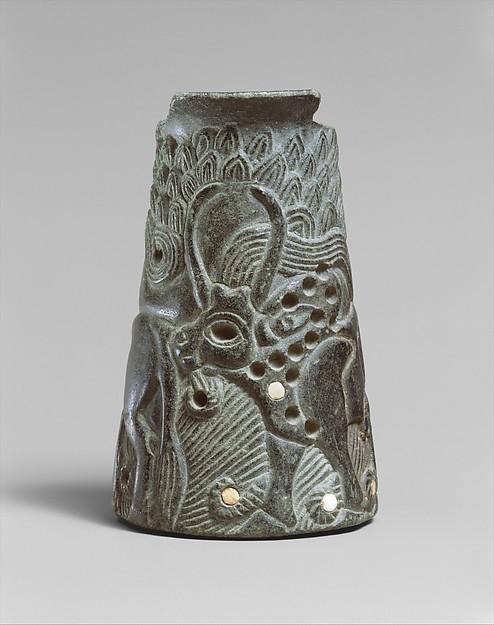2014.717

Object Title
Vessel with two zebu
Measurements
H. 11.4 cm (4-1/2 in.)
Creation Date
2600–2350 B.C.
Credit Line
Gift of Mrs. Constantine Sidamon-Eristoff, 2014
Museum Name
Culture
Country of Origin
Object Type
Materials / Techniques
Object URL
http://www.metmuseum.org/collection/the-collection-online/search/329087?rpp=30&pg=1&ft=eristoff&pos=1&imgno=0&tabname=object-information
Provenance Information
Excavated in Tarut Island, Saudi Arabia, in 1955 to 1960 or possibly 1970 by Anthony J. Mascarella; December 1972, first offered to The Metropolitan Museum of Art by Anthony J. Mascarella, Gallerie Sultan, Gretna, Louisiana; 19 January 1973, sold by Mr. Mascarella to Mrs. Constantine Sidamon Eristoff, New York; since 1978, on continuous loan to The Metropolitan Museum of Art (L.1978.31); acquired by the Museum in 2014, gift of Mrs. Constantine Sidamon-Eristoff, New York.
Exhibition Information
"Art of the First Cities: The Third Millennium B.C. from the Mediterranean to the Indus," The Metropolitan Museum of Art, New York, May 8–August 17, 2003.
Publication Information
Kohl, Philip L. 1974. Seeds of Upheaval: The Production of Chlorite at Tepe Yahya and an Analysis of Commodity Production and Trade in Southwest Asia in the Mid-Third Millennium, Thesis presented to the Department of Anthropology, Harvard University, pp. 166, 168, 170, plate XLVa.
Kohl, Philip L. 1975. “Carved Chlorite Vessels: A Trade in Finished Commodities in the Mid-Third Millennium.” Expedition 18/1, p. 27, no. 8.
Burkholder, Grace. 1984. An Arabian Collection: Artifacts from the Eastern Province. Boulder City, NV, cat. no. 10.
Pittman, H. 1984. Art of the Bronze Age - Southeastern Iran, West Central Asia, and the Indus Valley. MMA, NY. p. 20, fig. 4.
Zarins, Juris. 1989. “Eastern Saudi Arabia and External Relations: Selected Ceramic, Steatite, and Textual Evidence, 3500-1900 B.C.” In South Asian Archaeology 1985, edited by K. Frifelt and P Sorensen. London, p. 101, fig. 15.
"Art of the First Cities. The Third Millennium B.C. from the Mediterranean to the Indus", Ed. by Joan Aruz, with Ronald Wallenfels, 2003. The Metropolitan Museum of Art, New York. Cat. no. 226, pg. 330.
Kohl, Philip L. 1975. “Carved Chlorite Vessels: A Trade in Finished Commodities in the Mid-Third Millennium.” Expedition 18/1, p. 27, no. 8.
Burkholder, Grace. 1984. An Arabian Collection: Artifacts from the Eastern Province. Boulder City, NV, cat. no. 10.
Pittman, H. 1984. Art of the Bronze Age - Southeastern Iran, West Central Asia, and the Indus Valley. MMA, NY. p. 20, fig. 4.
Zarins, Juris. 1989. “Eastern Saudi Arabia and External Relations: Selected Ceramic, Steatite, and Textual Evidence, 3500-1900 B.C.” In South Asian Archaeology 1985, edited by K. Frifelt and P Sorensen. London, p. 101, fig. 15.
"Art of the First Cities. The Third Millennium B.C. from the Mediterranean to the Indus", Ed. by Joan Aruz, with Ronald Wallenfels, 2003. The Metropolitan Museum of Art, New York. Cat. no. 226, pg. 330.
Section of the AAMD Guidelines relied upon for the exception to 1970
Gift or bequest expected or on loan prior to 2008
Explain why the object fits the exception set forth above
The work was acquired by the donor, Mrs. Eristoff in 1973 and has been on continuous loan to and publicly displayed at The Metropolitan Museum of Art since 1978. The work has been published several times beginning in 1974. This is a fine and rare example of a relief-carved chlorite depicting in an inlaid technique two zebu striding one behind the other in a rich landscape. The modeled bodies of the animals are starkly outlined and emerge from a flat background. This vessel represents the only example in the Museum’s collection of a relief-carved chlorite vessel with figurative imagery, rather than geometric and vegetal motifs.